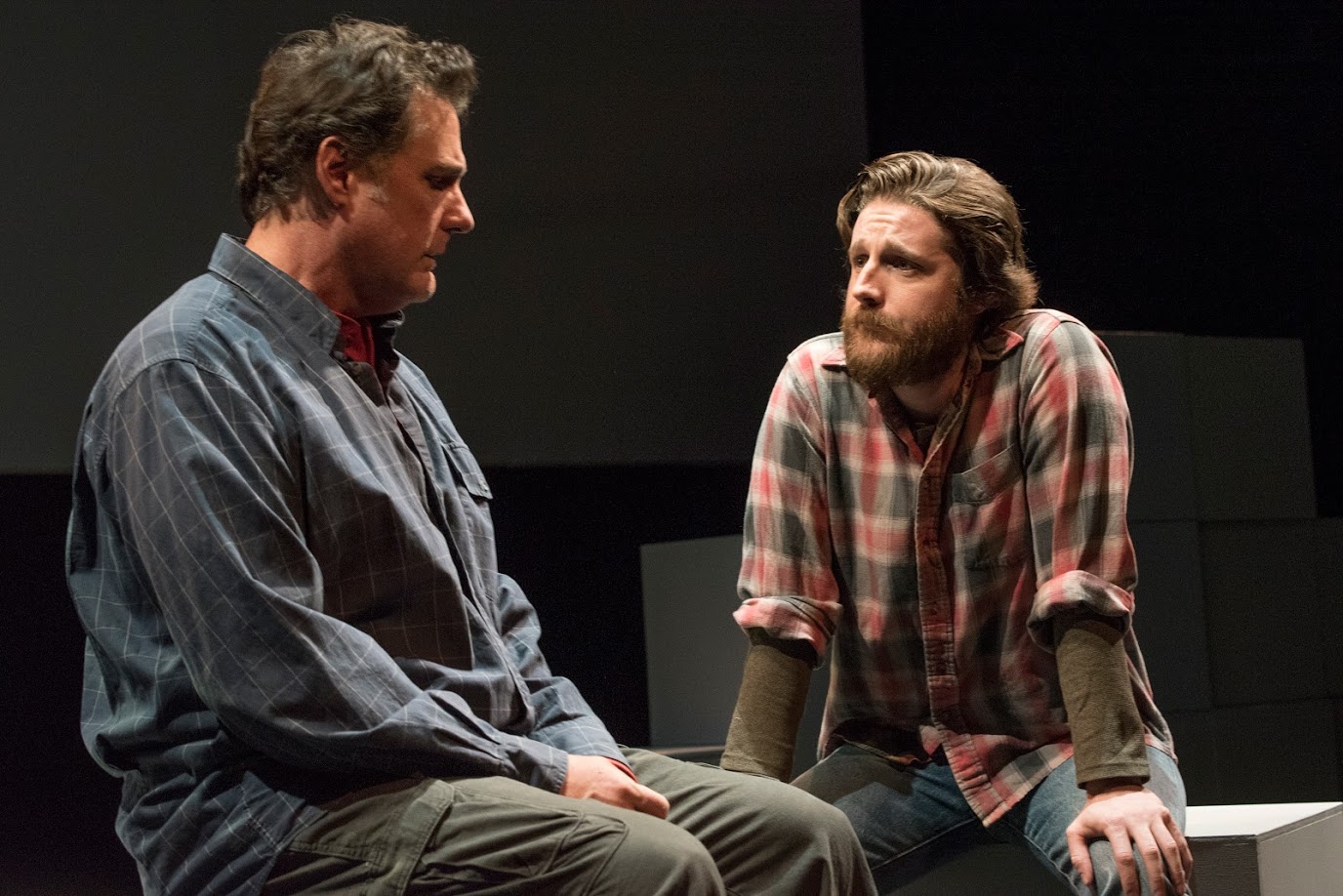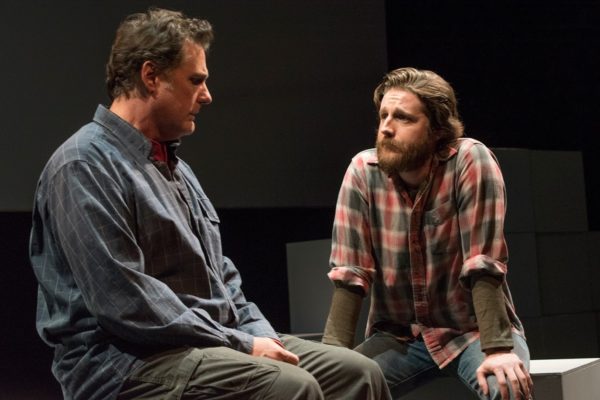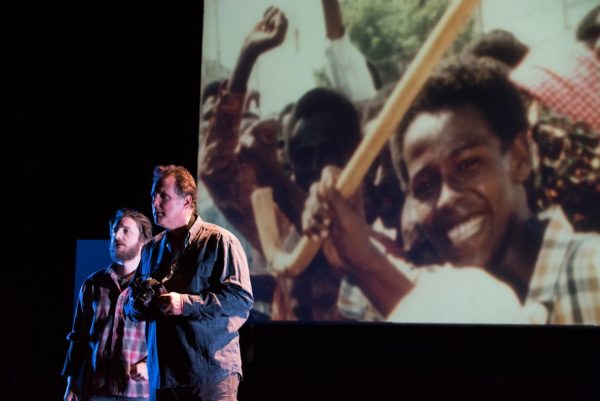
27 Oct Tall Tales/TIO Denver: “The Body of an American,” A Review
“The Body of an American” is now up at Denver’s Curious Theatre Company through December 9, 2017. Tickets here. Our Denver theater critic, award-winning author Mark Stevens, reviews the production.

Sean Scrutchins as Dan O’Brien (left) and Michael McNeill as Paul Watson in “The Body of An American.” Image, courtesy Curious Theatre Company.
“The Body of an American,” by Dan O’Brien, is about war for starters.
It’s also about truth versus public relations. It’s about the power of ghosts. It’s about journalism and its potential for falling short. It’s about the ability for most of us (even the politicians) to pretend war is a political matter, not something happening to real human beings. It’s about humiliation. It’s about the power of an image to capture the pure horror (how many have there been and how many do we need?) of war. It’s about the fog of war and the confusion of thinking about war. Why is war so much more visceral and brutal when it’s in-your-face inhumanity? When you can see its impact?
“The Body of an American” is ambitious. You can sense the brainpower behind the writing. Its themes are sweeping, but the play is an utterly internal story.
The story snapshot is this: A photojournalist takes a grisly, disturbing image of a dead American soldier being dragged and beaten through the streets of Mogadishu. And a playwright grappling with the ghosts of American History reaches out to the photographer and begins communicating with him about the Pulitzer-prize winning shot that altered the United States’ involvement in Somalia, changed the strategies of Al Qaeda’s terrorist network, and kept the U.S. out of such genocides as the one that took place a few years later in Rwanda. (At least, the fallout was significant; how much could be precisely tied to this one image is hard to know.) The photographer is the real-life Paul Watson; the playwright is the real-life Dan O’Brien.
“The Body of an American” is meta. It’s a playwright writing a play about himself and simultaneously trying to probe the post-war psyche of a journalist who was deeply impacted by the act of taking the photograph and watching the image take its emotional and political toll, including serving as the first communication to the soldier’s family about their son’s demise.
“The Body of an American” won the 2014 Horton Foote Prize for excellence in American theater. It was also awarded the PEN USA award for drama in 2013. There was an opera and a related book of poetry, too.
The framework for this drama has ample going for it. On a personal level, as a former national news television producer, I can vouch for the cowboy attitude of these globe-trotting correspondents who hop from war to natural disasters with a rambunctious, hungry appetite for misery and mayhem. They are a fearless and determined bunch. They appear to be callous, but we know they’re not. It takes a certain mettle to put yourself in the thick of the action with bulletproof vests on, taking notes or photos or both. If you watched the Ken Burns’ documentary about Vietnam, the importance of unflinching reporters who see through and challenge the PR baloney is vital.
Whether it’s the play itself or the staging, the Curious Theatre Company’s “The Body of an American” doesn’t snap in the manner of a typical piece of theater. The staging is unusual. The play only asks for two actors. Paul Watson is played by Michael McNeill and Dan O’Brien by Sean Scrutchins. But both take on multiple roles without much more than a barely-noticeable scene change or brief interruption—and then only to utter a few lines before moving back to their central role. (Most of the time.)
With the exception of a couple of monologues, the dialogue comes rapid-fire, ping-ponging back and forth. McNeill and Scrutchins pull off the timing with ease, but their voices occasionally remained at a level that was hard to hear, especially swallowed, now and then, by ambient, tuneless music that seemed to compete with the actors. Combined with all the jump-cutting, the play doesn’t give you much time to settle in with either character.
As usual with Curious Theatre Company, the set is evocative, intriguing. It features giant square blocks the actors move around in various configurations to suggest crude scene changes—and sometimes, it seems, just because the actors need something to do. Photographs and relevant video fill a giant and screen and atmospheric video render and flash on the blocks as well. The production requires exquisite timing between projections, sound and lighting and all the pieces click together like a Swiss watch (credit to director Chip Walton, Brian Freeland, Katie Gruenhagan and the set construction crew).
But “The Body of An American” is a largely internal play. It draws on personal issues—the photographer’s post-traumatic struggles, the playwright’s search for reality and truth.
There are some fine moments, particularly one near the end when Watson calls the home of the dead soldier’s family and holds an intricate and interesting conversation with the soldier’s brother. But even this confrontation is gentle, anguished.
Much of the play is O’Brien drawing out Watson (based on his actual exchanges with the real-life photographer) or cajoling Watson into narrating the highlights of his life. Drama takes a backseat to some snappy techniques and the ever-rotating roles.
“The Body of An American” is unusual and unforgettable. It’s heavy, thoughtful, and deals with important stuff. Don’t go thinking Big Drama, just head in knowing you will spend time with two storytellers who are both seeking truth through their own unique prisms.
“The Body of An American” runs through December 9.
More about Mark Stevens:

Mark Stevens, courtesy Cyrus McCrimmon
Telluride Inside… and Out’s monthly (more or less) column, Tall Tales, is so named because contributor Mark Stevens is one long drink of water. He is also long on talent.
Mark Stevens was raised in Massachusetts, but he’s been a Coloradoan since 1980.
Mark has worked as a print reporter, ((Denver Post, Christian Science Monitor, Rocky Mountain News), national news television producer, (MacNeil/Lehrer NewsHour) and school district communicator. He’s now laboring in the new economy, listed under “s” for self-employed public relations exec.
Mark has published three Colorado-based mysteries, “Antler Dust”(2007), “Buried by the Roan” (2011) and “Trapline” (2014). He is under contract for a fourth book in the series.
For more about Mark, check out his website.



Sorry, the comment form is closed at this time.